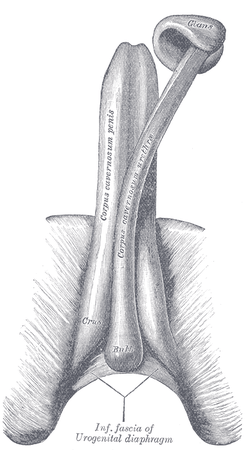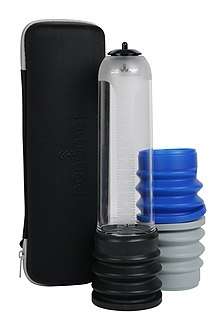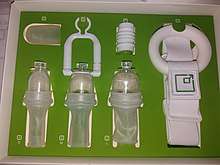Penis enlargement
Penis enlargement, or male enhancement, is any technique aimed to increase the size of a human penis. Some methods aim to increase total length, others the shaft's girth, and yet others the glans size. Techniques include surgery, supplements, ointments, patches, and physical methods like pumping, jelqing, and traction.

Surgical penis enlargement methods can be effective; however, such methods carry risks of complications and are not medically indicated except in cases involving a micropenis. Noninvasive methods have received little scientific study, and most lack scientific evidence of effectiveness. However, limited scientific evidence supports some elongation by prolonged traction. Some quack products may improve penis erection, mistaken by consumers for penis enlargement.
Surgical methods

There are several surgical penis enlargement treatments, most of which carry a risk of significant complications.[1] Procedures by unlicensed surgeons can lead to serious complications.[2]
Surgical penis enlargement methods include penile augmentation and suspensory ligament release. Penile augmentation involves injecting fat cells into the penis or grafting fat cells onto the penis. Injecting fat cells into the penis can cause swelling and deformity; in some instances, removal of the penis may be necessary. Grafting fat cells onto the penis can be effective; however, the increase in size may disappear over time. Suspensory ligament release increases flaccid penis length, but does not increase the length of an erect penis[3] and can create problems with sexual function.[4]
The American Urological Association (AUA) and the Urology Care Foundation "consider subcutaneous fat injection for increasing penile girth to be a procedure which has not been shown to be safe or efficacious. The AUA also considers the division of the suspensory ligament of the penis for increasing penile length in adults to be a procedure which has not been shown to be safe or efficacious."[5] Complications from penis enlargement procedures include scarring that may lead, ultimately, to penis shrinkage or erectile dysfunction.[6][7]
Other surgical treatments include the injection of dermal fillers, silicone gel, or PMMA.[8][9] Dermal fillers are also not approved by the US Food and Drug Administration (FDA) for use in the penis.[10]
Because of great risk and uncertainty, medical professionals are generally skeptical of penile enlargement and avoid attempting it.[7][11] A 2019 study in Sexual Medicine Reviews found that surgical methods of penis enlargement are typically ineffective and can be damaging to both physical and mental health.[3] The authors found that such treatments are "'supported by scant, low-quality evidence... Injectables and surgery should remain a last option, considered unethical outside of clinical trials'".[12] According to the study, "'overall treatment outcomes were poor, with low satisfaction rates and significant risk of major complications, including penile deformity, shortening, and erectile dysfunction'".[3]
Medical doctors do treat micropenis with surgical procedures.[4] In such cases, surgery can improve urinary or sexual function.[13]
Supplements
Penis-enlargement pills, patches, and ointments are sold online. Such products are generally considered ineffective.[14]
Physical techniques
Physical techniques involve extension devices, hanging weights, and vacuum pressure. There is also significant overlap between techniques intended to enlarge the penis and techniques intended to achieve other, related objectives, such as reversing impotence, extending the duration of erections, or enhancing sexual climax.
Pumping

Commonly called a "penis pump", a vacuum erection device, or VED, creates negative pressure that expands and thereby draws blood into the penis.[16][17] Medically approved VEDs, which treat erectile dysfunction, limit maximum pressure, whereas the pumps commonly bought by consumers seeking penis enlargement can reach dangerous pressure, damaging penis tissue.[18] To retain tumescence after breaking the device's airtight seal, one must constrict the penis' base, but constriction worn over 30 minutes can permanently damage the penis and cause erectile dysfunction.[19] Although vacuum therapy can treat erectile dysfunction sufficiently to prevent penis deterioration and shrinkage,[17] clinical trials have not found it effective for penis enlargement.[20][21]
Jelqing
The latinized name "jelqing" is the corrupt form derived from the Persian jalq zadan (جلق زدن), jalq meaning "to masturbate" followed by an auxiliary verb zadan meaning "to strike, hit or throb". Performed on the halfway tumescent penis, jelqing is a manual manipulation of simultaneous squeezing and stroking the shaft from base to corona. Also called "milking",[22] the technique has ancient Arab origins.[23] Despite many anecdotal reports of success, medical evidence is absent.[24] Journalists have dismissed the method as biologically implausible,[25] or even impossible, albeit unlikely to seriously damage the penis.[26] Still, if done excessively or harshly, jelqing could conceivably cause ruptures, scarring, disfigurement, and desensitization.[24][25]
Traction

Traction is a nonsurgical method to lengthen the penis by employing devices that pull at the glans of the penis for extended periods of time. As of 2013, the majority of research investigating the use of penile traction focuses on treating the curvature and shrinkage of the penis as a result of Peyronie's disease, although some literature exists on the impact on men with short penises.[27]
Scientific evidence supports some elongation by prolonged traction.[28]
Reasons for seeking penis enlargement
Some men seeking penis enlargement have normal-sized penises, and many may experience penile dysmorphophobia by underestimating their own penis size while overestimating the average penis size.[13]
Society and culture
In 2013 in Vietnam, many Vietnamese men attempted to enlarge their penises by injecting liquid silicone into them. They were hospitalized for complications such as infections, necrosis, tumors, swelling, deformities, and sexual dysfunction.[29]
References
- Levine, LA; Becher, E; Bella, A; Brant, W; Kohler, T; Martinez-Salamanca, JI; Trost, L; Morey, A (April 2016). "Penile Prosthesis Surgery: Current Recommendations From the International Consultation on Sexual Medicine". The Journal of Sexual Medicine. 13 (4): 489–518. doi:10.1016/j.jsxm.2016.01.017. PMID 27045255.
- Christie Blatchford (May 2, 2001). "The beauty butchers". National Post. Retrieved July 14, 2014.
- "Penis enlargement surgery ineffective and potentially dangerous". News-Medical.net. May 13, 2019.
- "Does penis enlargement work? Methods and effectiveness". Medical News Today.
- "American Urological Association - Penile Augmentation Surgery". www.auanet.org. Retrieved 2018-03-14.
- Nugteren HM, Balkema GT, Pascal AL, Schultz WC, Nijman JM & van Driel MF, "Penile enlargement: From medication to surgery", J Sex Marital Ther, 2010;36(2):118–23.
- Vardi Y, "Is penile enlargement an ethical procedure for patients with a normal-sized penis?", Eur Urol, 2006 Apr;49(4):609-11.
- Shamsodini, Ahmad; Al-Ansari, Abdulla A.; Talib, Raidh A.; Alkhafaji, Haidar M.; Shokeir, Ahmed A.; Toth, Csaba (December 2012). "Complications of penile augmentation by use of nonmedical industrial silicone". The Journal of Sexual Medicine. 9 (12): 3279–3283. doi:10.1111/j.1743-6109.2011.02563.x. ISSN 1743-6109. PMID 22145947.
- Fukuda, Hidetsugu; Endo, Hiromi; Katsuzaki, Jyoji; Mukai, Hideki (2016-08-01). "Development of nodules on the glans penis due to hyaluronic acid filler injection". European Journal of Dermatology: EJD. 26 (4): 416–417. doi:10.1684/ejd.2015.2600. ISSN 1952-4013. PMID 26081014.
- Health, Center for Devices and Radiological. "Dermal Fillers (Soft Tissue Fillers)". www.fda.gov. Retrieved 2018-03-14.
- R. Morgan Griffin (2010). "Penis enlargement: Does it work?". WebMD. Retrieved July 28, 2011.
- G, Kashmira; EDT, er On 5/10/19 at 6:55 AM (May 10, 2019). "Penis enlargements are "ineffective and risky" and leave men at mercy of charlatans, study finds". Newsweek.
- Campbell J & Gillis J, "A review of penile elongation surgery", Transl Androl Urol, 2017 Feb;6(1):69–78.
- Nugteren, Helena M.; Balkema, G. T.; Pascal, A. L.; Schultz, W. C. M. Weijmar; Nijman, J. M.; van Driel, M. F. (2010). "Penile enlargement: from medication to surgery". Journal of Sex & Marital Therapy. 36 (2): 118–123. doi:10.1080/00926230903554453. ISSN 1521-0715. PMID 20169492.
- "Penomet". Penomet Penis Pump. Retrieved 2019-12-06.
- Stein MJ, Lin H & Wang R, "New advances in erectile technology", Ther Adv Urol, 2014 Feb;6(1):15–24.
- Qian SQ, Gao L, Wei Q & Yuan J, "Vacuum therapy in penile rehabilitation after radical prostatectomy: Review of hemodynamic and antihypoxic evidence", Asian Journal of Andrology, 2016 May–Jun;18(3):446–51.
- Daniel Engber, "Do penis pumps work?", Slate, 29 Jun 2006.
- Lehrfeld, T.; Lee, D. I. (2009). "The role of vacuum erection devices in penile rehabilitation after radical prostatectomy". International Journal of Impotence Research. 21 (3): 158–164. doi:10.1038/ijir.2009.3. PMID 19225465.
- Kweon Sik Min, ch 20 "Penile traction therapy (penile lengthening device)", in Nam Cheol Park, Sae Woong Kim & Du Geon Moon, eds, Penile Augmentation (Springer, 2016), p 162.
- Sarah L Hecht & Jason C Hedges, ch 13 "Vacuum therapy for erectile dysfunction", in Tobias S Köhler & Kevin T McVary, eds, Contemporary Treatment of Erectile Dysfunction: A Clinical Guide, 2nd edn (Humana Press, 2016), p 181.
- Salvini, Mike (12 April 2005). "Size matters". Salon. Retrieved 6 January 2013.
- Wylie, Kevan R.; Eardley, Ian (1 June 2007). "Penile size and the ?small penis syndrome?". BJU International. 99 (6): 1449–1455. doi:10.1111/j.1464-410X.2007.06806.x. PMID 17355371.

- Mayo Clinic staff. "Penis-enlargement products". Mayo Clinic. Retrieved 6 January 2013.
- Wanjek, Christopher (February 20, 2007). "Penis enlargement products come up short". livescience.com. Tech Media Network. Retrieved 6 January 2013.
- Johanson, Sue (2011). "Jelqing". Talk Sex with Sue Johanson. Retrieved 14 June 2013.
- Eric C, Geralb B (February 2013). "Penile traction therapy and Peyronie's disease: a state of art review of the current literature". Ther Adv Urol. 5 (2): 59–65. doi:10.1177/1756287212454932. PMC 3547530. PMID 23372611.
- Oderda M & Gontero P, "Non-invasive methods of penile lengthening: Fact or fiction?", BJU Int, 2011 Apr;107(8):1278––82.
- "More Vietnamese men using silicone to enlarge their penises". Thanh Nien News. August 31, 2013. Retrieved July 14, 2014.